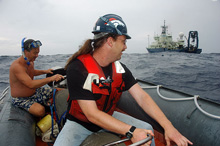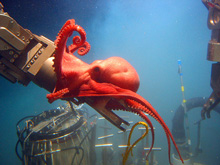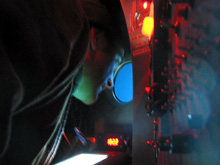
After a successful launch of the deep submergence vehicle (DSV) Alvin, second mate Pete Leonard pilots the Avon back to the research vessel (R/V) Atlantis, while seaman Patrick Hennessey stows his gear. Click image for larger view and image credit.
Bruce Strickrott, chief pilot of the DSV Alvin, peers out of the submersible while flying along the sea floor. Click image for larger view and image credit.
The Brine Lake
May 31, 2006
Harry Roberts
Louisiana State University
26° 21.28 N
094° 29.86 W
![]()
![]() Video of the brine lake at the bottom of the sea. (Quicktime, 1.36 Mb.)
Video of the brine lake at the bottom of the sea. (Quicktime, 1.36 Mb.)
As we descended from the south flank of the AC 601 mound, diving down into the central crater, an amazing scene slowly revealed itself below. There at the bottom of this crater on the ocean floor, at a depth of about 2,330 m (7,644 ft) was a “lake.” We were approaching the "shoreline," the first feature to come into focus. It had a “swash zone and beach ridges” that mimicked features one could observe along the coastline of the northeastern Gulf’s Florida panhandle.
The reason these features were immediately visible to us was because they were white and highly reflective in the deep submergence vehicle (DSV) Alvin's lights. As we moved closer, it became clear that we were observing a brine lake, with a well-defined interface between the dense lake water and the overlying seawater.
The brine was probably derived from solution of a shallow salt body at the core of the overall mound. The lake shoreline had familiar features like a high-water mark, a wave run-up zone, and a former higher lake level shoreline. These are features commonly associated with regular sandy coasts. However, when we got closer to the lake it became apparent that the shoreline was defined by clots of white material.
As we took the sub into the brine lake, the pressure wave from the sub’s movement across the lake created waves on the interface between the brine and the overlying normal-density seawater.
We watched these waves break on the “beach,” like storm waves approaching and breaking on a sandy coastline. The white clots that were entrained in the waves were reminiscent of what happens on arctic beaches after breakup of the shore-attached ice. There, ice blocks are driven by waves onto the beach where they concentrate in the swash zone, just like the white clots on this brine lake. It was unbelievable to think that it took us 1.5 hours to descend to the depths of the ocean floor and there find a “beach” complete with breaking waves. Unreal! We’re still unsure of the composition of the white clots that define the shoreline and are scattered throughout the brine lake. They appear to be rafts of crystalline material, perhaps elemental sulfur. This is one site that definitely deserves more study.

This stunning octopod, Benthoctopus sp., seemed quite interested in the DSV Alvin’s port manipulator arm. Those inside the sub were surprised by the octopod’s inquisitive behavior. Click image for larger view and image credit.
Endnote:
Due to the special nature of this location, the science team amended the dive plan to include another dive at this site. On May 31, DSV Alvin Chief Pilot Bruce Strickrott, Chief Scientist Chuck Fisher, and observer Jeremy Potter returned to the Brine Lake for second look. You can imagine their surprise when an orange apparition appeared out of the darkness. It certainly seems as if this is a particularly special site.
Sign up for the Ocean Explorer E-mail Update List.





























